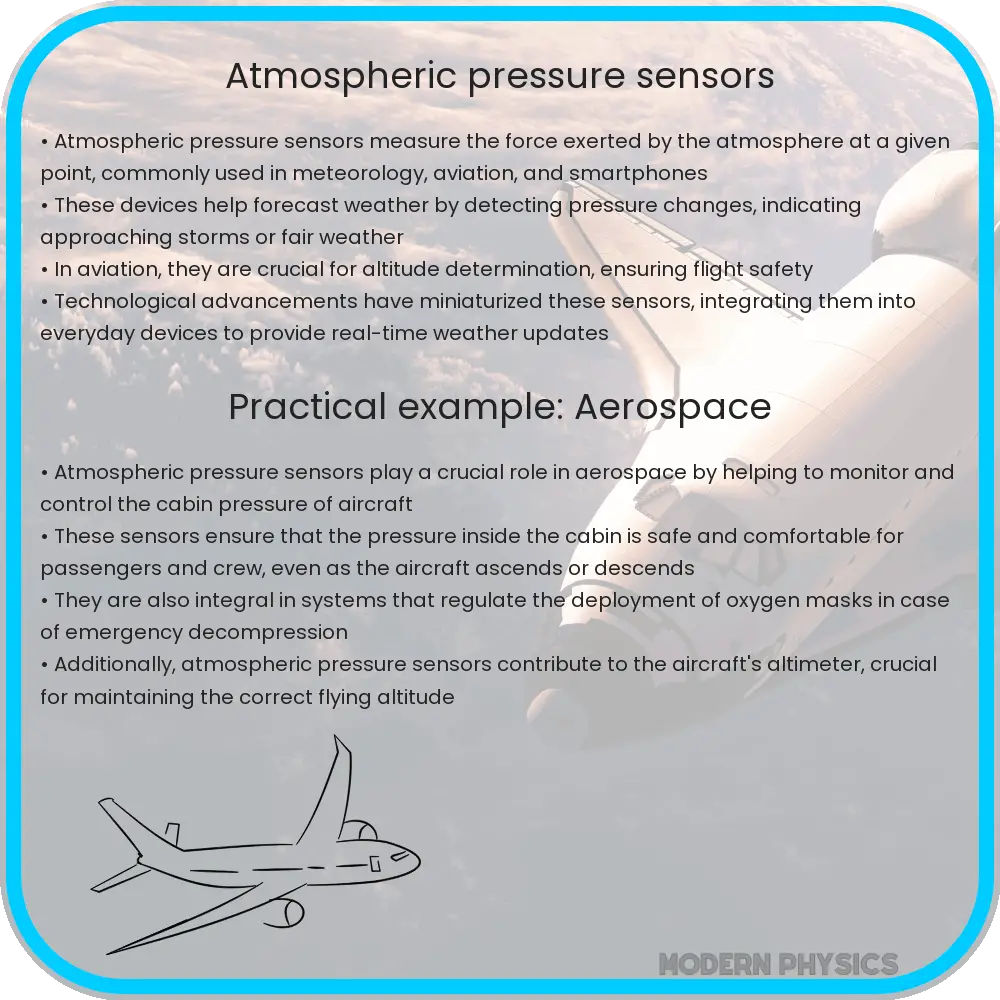Essential guide to atmospheric pressure sensors, their operation, accuracy, and applications in fields like meteorology and aviation.

Understanding Atmospheric Pressure Sensors: Functionality and Importance
Atmospheric pressure sensors, also known as barometers, play a critical role in meteorology, aviation, and even in everyday weather applications. These devices measure the pressure exerted by the atmosphere and provide data essential for weather forecasting, altitude determination in aircraft, and scientific research. This article explores the accuracy and durability of these sensors and their application in geophysical studies.
How Do Atmospheric Pressure Sensors Work?
Atmospheric pressure sensors operate based on one of several principles, including mechanical, electronic, and optical sensor technologies. Mechanical sensors, such as aneroid barometers, use a small, flexible metal box called an aneroid cell, which expands and contracts with changes in atmospheric pressure. Electronic sensors, on the other hand, often utilize piezoresistive or capacitive techniques where changes in pressure alter an electrical parameter, thereby enabling pressure measurement.
Accuracy of Atmospheric Pressure Sensors
The accuracy of atmospheric pressure sensors is paramount, especially in applications requiring precise data for forecasting and navigational aids. Several factors influence the accuracy of these sensors, including:
- Technology used: Different technologies have inherent accuracy levels. For example, capacitive sensors are generally more accurate than piezoresistive sensors.
- Calibration: Regular calibration is essential to maintain sensor accuracy over time.
- Environmental factors: Temperature, humidity, and altitude can affect sensor readings and need to be accounted for in the sensor design and operation.
The standard measure of accuracy for these sensors is often given in terms of percentage of full scale or in hectopascals (hPa). High-quality sensors can achieve accuracies as tight as ±0.1 hPa, which is crucial for applications such as aviation and detailed scientific research.
Durability Considerations for Atmospheric Pressure Sensors
Durability is another critical aspect of atmospheric pressure sensors, especially when deployed in harsh environments. These sensors must withstand factors such as:
- Temperature extremes
- Moisture and humidity
- Chemical exposure
- Mechanical stress and vibrations
Manufacturers enhance the durability of these sensors using robust materials like stainless steel or engineered plastics and employing protective coatings. These measures ensure that the sensors remain operational over their intended lifespan, providing reliable data despite environmental challenges.
Applications in Geophysical Research
Atmospheric pressure sensors find extensive applications in geophysical research, helping scientists understand and predict atmospheric phenomena. These sensors are integral in studies related to:
- Weather patterns and climate change
- Sea-level dynamics and tsunamis
- Volcanic activity monitoring
- Earthquake prediction
By providing accurate and continuous pressure data, these sensors contribute significantly to the modeling and analysis of various geophysical processes. For instance, variations in atmospheric pressure can help predict the approach of large storm systems, or sudden changes might indicate volcanic activity.
Advanced sensor networks globally help in gathering data which, when analyzed, provides insights into long-term climatic trends and immediate weather conditions. This information is crucial for preparing for natural disasters and understanding the Earth’s changing climate.
Future Trends in Atmospheric Pressure Sensor Technology
As technology advances, the development of atmospheric pressure sensors continues to evolve, incorporating more sophisticated features aimed at enhancing both their precision and utility. Key trends in this area include:
- Miniaturization: Development of smaller, more compact sensors that can be deployed in diverse environments without intruding on the surrounding area.
- Integration with other sensors: Combining atmospheric pressure sensors with other types of sensors, such as humidity and temperature sensors, to provide more comprehensive data sets.
- Improved connectivity: Enhancing sensor connectivity using technologies like IoT (Internet of Things), which allows for real-time data collection and analysis from remote locations.
- Artificial Intelligence: Implementing AI to interpret vast amounts of data more accurately and predict changes in atmospheric conditions with greater precision.
These advancements not only improve the functionality of atmospheric pressure sensors but also broaden their applicability in both everyday and specialized scientific contexts, making them more useful than ever before.
Conclusion
Atmospheric pressure sensors, or barometers, are indispensable tools across many fields, including meteorology, aviation, and geophysical research. Their ability to accurately measure and record atmospheric pressure plays a crucial role in our understanding of weather patterns, environmental phenomena, and scientific forecasting. Ensuring their accuracy through regular calibration and careful consideration of environmental impacts is essential for obtaining reliable data. Furthermore, advancements in sensor technology promise to enhance their precision, durability, and functionality. As we continue to encounter new challenges due to changing global climate conditions, the role of these sensors in monitoring and responding to environmental changes becomes more significant. Atmospheric pressure sensors not only help us to navigate the skies and understand the weather today, but they also equip us with the knowledge to predict and prepare for the future.
